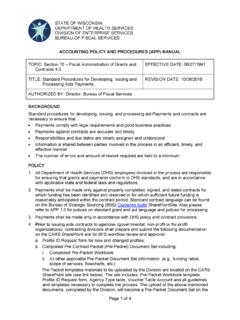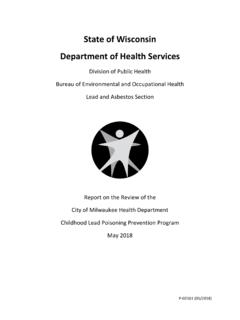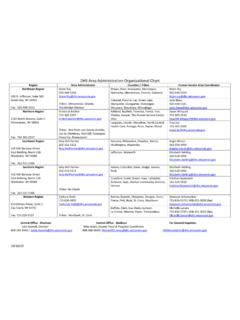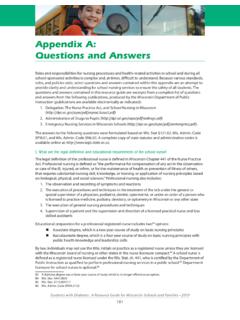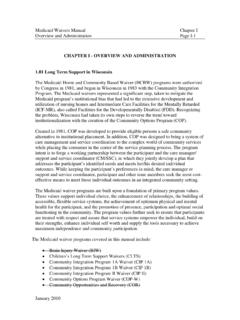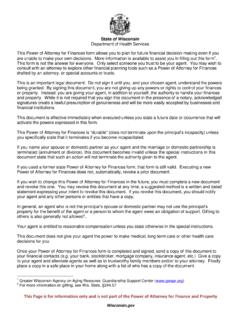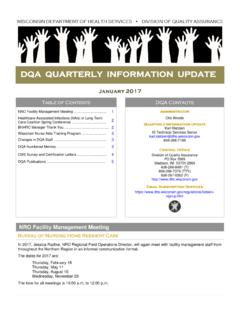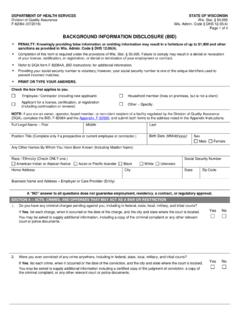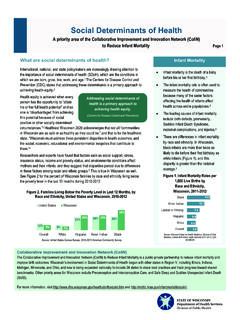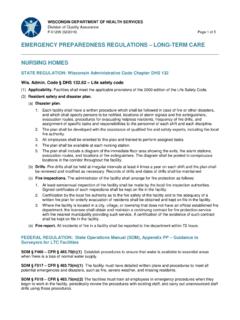Transcription of Tuberculosis Screening and Testing: Residents of Care ...
1 1 Tuberculosis Screening and Testing: Residents of Care Facilities (to include Assisted Living and Nursing Homes) TB risk assessment : Use of a questionnaire to determine a person s risk for TB infection. Symptom evaluation: assessment for signs and symptoms of active Tuberculosis (TB) disease. TB testing: Performing an interferon gamma release assay (IGRA) blood test or tuberculin skin test (TST) to determine if a person has been infected with M. Tuberculosis complex bacteria. Recommendations and Requirements for Admission P-02382A (8/2019) Wisconsin Tuberculosis Program | Wisconsin Department of Health Services Page 1 of 4 Definitions: Screening for the presence of communicable disease, including TB, is required upon admission by Department of Health Services (DHS) WI Admin. Codes for Residents of care facilities and includes the following three steps: TB risk assessment Perform a baseline TB risk assessment questionnaire to determine risk for TB infection.
2 See resources for an example questionnaire1. Symptom evaluation Symptoms for TB include cough lasting more than three weeks AND one of more of the following: coughing up blood, fever, night sweats, unexplained weight loss, or fatigue. TB testing Perform baseline testing for all Residents without documented evidence of prior LTBI or TB disease. See page 2 for Screening of Residents with previous positive result. IGRA or TST may be performed; IGRA is preferred. If testing is positive, obtain chest x-ray and refer to provider for additional workup for TB disease. In the absence of newly identified risks or symptoms, previous documented negative IGRA or TST results (within 12 months) may be used. If TST is used as the baseline testing, 2-step testing is recommended for Residents who have not had TST testing previously or have only had one negative TST test greater than 12 months ago. If 2 or more TST tests have been previously performed, all results are negative, and documentation of results is available, a one-step TST may be performed before admission.
3 Initial risk assessment , testing, and symptom evaluation can serve as a baseline should an exposure occur and a TB contact investigation become necessary. Additionally, baseline risk assessment , testing, and symptom evaluation can facilitate the detection and treatment of latent Tuberculosis infection (LTBI) and TB disease to reduce the risk of transmission within the facility. 2 Residents that have documented positive IGRA or TST results or documented treatment for TB or LTBI do not need baseline TST or IGRA. Obtain a baseline chest x-ray and symptom evaluation. Previous baseline radiographs (within 6 months) may be used for asymptomatic Residents . Chest x-ray should be repeated if resident is symptomatic. Serial (annual) follow-up chest x-rays are not recommended. Treatment for LTBI is recommended to reduce the risk of progression to active TB disease. P-02382A (8/2019) Wisconsin Tuberculosis Program | Wisconsin Department of Health Services Testing Residents with a History of Positive IGRA or TST Individuals with a history of TB or LTBI will likely have positive IGRA and TST results for their lifetime.
4 Page 2 of 4 Admission Screening Timing depends on facility type (see Table 1 on page 4). Ideally done immediately prior to admission. Who May Perform Screening The type of clinician qualified to perform the Screening depends on facility type (see Table 1 on page 4). Timing and Frequency of Screening Annual (Serial) Testing for Residents : Most Wisconsin health care facilities are considered low risk for TB; annual testing by IGRA or TST is not Readmission Screening If a resident with a negative baseline leaves the facility and is later readmitted, perform a risk assessment questionnaire and symptom evaluation. Only re-test if resident has incurred new risk factors for TB infection. 3 For those determined to have been exposed, perform evaluation for signs and symptoms of TB disease. For those who previously had negative results, administer an IGRA or TST . Do not perform IGRA or TST for persons with previous positive results.
5 Repeat symptom evaluation and IGRA or TST at 8 10 weeks after the end of exposure if the initial result was negative. If the symptom evaluation or the initial or the 8- to 10-week follow-up IGRA or TST is positive, further evaluate the resident for TB disease, including performing a chest x-ray. Residents , family, and caregivers should be educated on the signs and symptoms of TB disease and should seek medical evaluation if these occur. P-02382A (8/2019) Wisconsin Tuberculosis Program | Wisconsin Department of Health Services Testing After a TB Exposure Event Type of Facility Wis. Admin. Code ch. DHS* Clinician to Perform Timing Skilled nursing facility (nursing home) 132 Physician, physician assistant, or advanced nurse practitioner 90 days prior to admission Community-based residential or respite facilities (CBRFs) 83 Physician, physician assistant, advanced nurse practitioner, or licensed registered nurse 90 days prior to OR within 7 days after admission Adult family homes 88 Physician, physician assistant, or licensed registered nurse 90 days prior to OR within 7 days after admission Facility serving people with developmental disabilities 134 Physician, physician assistant, or advanced nurse practitioner Not specified; prior to admission is recommended Community substance abuse treatment facilities 75 Not specified Immediately upon admission and annually thereafter Page 3 of 4 *For more information, please visit: 1.
6 Summary of WI Administrative Codes 4 P-02382A (8/2019) Wisconsin Tuberculosis Program | Wisconsin Department of Health Services Resources 1. Wisconsin Tuberculosis Program TB Risk assessment Questionnaire Screen. 2. Centers for Disease Control and Prevention. (2005) Guidelines for preventing the transmission of mycobacterium Tuberculosis in health-care settings. MMWR 2005: 54(No. RR-17). 3. Centers for Disease Control and Prevention (2017). Official American Thoracic Society/Infectious Diseases Society of America/Centers for Disease Control and Prevention clinical practice guidelines: Diagnosis of Tuberculosis in adults and children, Clinical Infectious Diseases, 64(2): 111-5. Retrieved from Page 4 of 4
